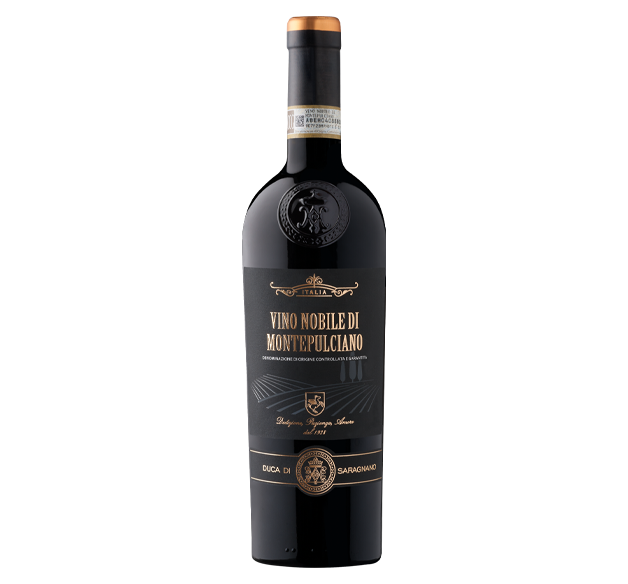DUCA DI SARAGNANO 2020 - Vino Nobile Di Montepulciano DOCG, Tuscany - Italy
DUCA DI SARAGNANO - Vino Nobile Di Montepulciano DOCG, Tuscany - Italy
Deeply intense red colour shows light garnet hues in the glass. The broad and long-lasting nose boasts violet, forest berries, spices and tobacco scents. The well-structured tannins from slow aging in oak barrels add structure, elegance and the right smoothness level to this wine.
 ITALY
ITALY
 Tuscany
Tuscany
Product Description
Description
Deeply intense red colour shows light garnet hues in the glass. The broad and long-lasting nose boasts violet, forest berries, spices and tobacco scents. The well-structured tannins from slow aging in oak barrels add structure, elegance and the right smoothness level to this wine.
How to pair it
-
 Meat
Pair with roasted red meats, game, braised meats
Meat
Pair with roasted red meats, game, braised meats
-
 Cheese
Pair with soft cheese
Cheese
Pair with soft cheese
Accolades
Awards

Luca Maroni 96 Points
An Italian wine expert, famous wine journalist, critic and author, Luca Maroni has also created his own rating system for wines, contributed to wine education and has collaborated with top Italian wineries.
Wine Facts
| Product Type | Red Wine |
|---|---|
| Vintage | 2020 |
| Region | Tuscany |
| Country | ITALY |
| Volume(ml) | 750 |
| Winemakers | Francesco Franchetti & Andrea Bernardini |
| Aging | 18 months in large oak barrels plus a minimum of 6 months in stainless steel tanks. |
| Alcohol | 13% |
| Mouth Attribute | Elegant, Oaky, Structured, Smooth, Tannic |
| Nose Attribute | Red Berries, Spices, Tobacco |
| SKU | IT172 |
Vineyard Info
The Vino Nobile di Montepulciano production zone comprises the land belonging to the municipal area of Montepulciano in the province of Siena, a particularly favourable location on the hilly ridge between Val di Chiana and Val d’Orcia.
The land in this production zone is at altitudes of between 250 and 580 metres a.s.l. and the quality of the wines produced here is largely influenced by its climactic and geological features. The soil is composed mainly by calcareous clay and the main grape variety planted here is a particular clone of Sangiovese called Prugnolo Gentile supported by Merlot and other indigenous grape varieties like Canaiolo, Ciliegiolo, Colorino, etc. These terrains derive directly from the deep-sea water that emerged during geological era of Pliocene.
The Spurred-Cordon and Guyot, are the main growing method in this specific area.
Reviews & Ratings
Description
Deeply intense red colour shows light garnet hues in the glass. The broad and long-lasting nose boasts violet, forest berries, spices and tobacco scents. The well-structured tannins from slow aging in oak barrels add structure, elegance and the right smoothness level to this wine.
How to pair it
-
 Meat
Pair with roasted red meats, game, braised meats
Meat
Pair with roasted red meats, game, braised meats
-
 Cheese
Pair with soft cheese
Cheese
Pair with soft cheese
Awards

Luca Maroni 96 Points
An Italian wine expert, famous wine journalist, critic and author, Luca Maroni has also created his own rating system for wines, contributed to wine education and has collaborated with top Italian wineries.
| Product Type | Red Wine |
|---|---|
| Vintage | 2020 |
| Region | Tuscany |
| Country | ITALY |
| Volume(ml) | 750 |
| Winemakers | Francesco Franchetti & Andrea Bernardini |
| Aging | 18 months in large oak barrels plus a minimum of 6 months in stainless steel tanks. |
| Alcohol | 13% |
| Mouth Attribute | Elegant, Oaky, Structured, Smooth, Tannic |
| Nose Attribute | Red Berries, Spices, Tobacco |
| SKU | IT172 |
The Vino Nobile di Montepulciano production zone comprises the land belonging to the municipal area of Montepulciano in the province of Siena, a particularly favourable location on the hilly ridge between Val di Chiana and Val d’Orcia.
The land in this production zone is at altitudes of between 250 and 580 metres a.s.l. and the quality of the wines produced here is largely influenced by its climactic and geological features. The soil is composed mainly by calcareous clay and the main grape variety planted here is a particular clone of Sangiovese called Prugnolo Gentile supported by Merlot and other indigenous grape varieties like Canaiolo, Ciliegiolo, Colorino, etc. These terrains derive directly from the deep-sea water that emerged during geological era of Pliocene.
The Spurred-Cordon and Guyot, are the main growing method in this specific area.
